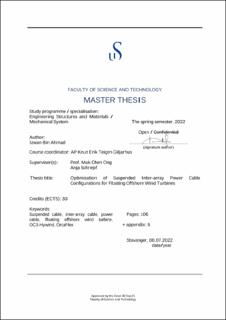| dc.description.abstract | Floating offshore wind turbines (FOWTs) have been demonstrated to be highly promising for effectively harnessing energy from offshore wind in deeper water areas where installing bottom-fixed offshore wind turbines is not feasible. However, overcoming technological obstacles to commercialise floating offshore wind farms in deep water is still a work in progress, with inter array cable designs being one of the most crucial areas to develop. Therefore, this study presents a novel configuration of suspended inter array power cables using subsea buoys between two OC3-Hywind FOWTs supporting a 5MW turbine. In this configuration, the inter array cable is kept afloat between the seabed and the sea surface by distributing several buoys along the cable. Each buoy is fitted with a bend stiffener on both ends. An optimisation methodology for this novel configuration is proposed, and the dynamic response of this configuration accounting for the effect of marine growth in 320 m range of water depth is investigated. The study of dynamic responses considers the impact on cable effective tension, minimum bend radius, and horizontal excursion. Configurations with copper cable and aluminium cable are investigated. Two differently sized buoys are used. Extreme environmental conditions of the Norwegian Sea and the rated operating environment based on the OC3-Hywind report are employed. The suspended inter-array power cable concept is proven to be feasible using the proposed buoy setup and optimisation methodology. The smaller buoys yield the most optimal designs for both cable types compared to the bigger buoys. Configurations using aluminium cables result in the lowest effective tension, but copper cables can withstand higher effective tension with a significantly larger safety margin to the minimum breaking load than the aluminium cable configuration. Copper cable configurations also result in a lower horizontal excursion than the aluminium cable configuration. The largest minimum bend radius occurs when the buoys are closely spaced.
Keywords: Suspended cable, inter-array cable, power cable, floating offshore wind turbine, OC3 Hywind, OrcaFlex | |
